Association of Positive Results of Single Serum Biomarker with the Clinical Parameters
Introduction
With dramatical population growth and aging worldwide, cancer incidence and mortality become the major public health concern affecting more than millions of people each year [1]. With nearly one-quarter of the people in the world, cancer deaths of China as well as have a severe impact on global cancer trend and burden [2]. As we know, early diagnosis usually could increase the chances of successful treatment which gives great promises for cancer patients [3]. And major advances have been made in screening tissue or blood samples for cancer-specific biomarkers that can detect the cancer as early as possible [4,5]. So far, series of serum biomarkers have been adapted to clinical use for cancer diagnosis, therapy and prognosis monitoring [6]. For example, AFP, a marker for hepatocellular carcinoma, sometimes is used to assess hepatic masses in patients at particular risk for developing hepatic malignancy [7].
CEA is expressed in normal mucosal cells and overexpressed in adenocarcinoma, especially colorectal cancer [8,9]. NSE has been evaluated in numbers of malignant tumours, such as lung cancer [10,11]. HE4 [12-14] and CA125 [15,16] have an obvious elevated expression levels in ovarian cancers. CA15-3 is a protein made by a variety of cells, particularly breast cancer cells [17,18]. Elevated levels of CA19-9 occur primarily in patients with pancreatic cancers but also have been reported in patients with other malignancies [19-22]. It was reported CA72-4 was the most correlative serum biomarker for the detection of gastric cancer in Chinese population [23,24]. Serum Ferritin (SF) can be used as a prognostic biomarker for survival in relapsed or refractory metastatic colorectal cancer [25]. With adenocarcinoma in older men, significant PSA elevations have enough specificity to make the diagnosis of prostate cancer, and so on [26,27].
Due to the convenience and non-invasion, those serum biomarkers have been widely used in clinical practice. However, to date, many serum biomarkers have been demonstrated poor specificity and efficacy, even among the most correlative cancers. Because of the overabundance of diagnostic value and clinical significance, it is necessary for doctors and patients to have a thorough understanding of those serum biomarkers [28,29]. The study aimed to provide a comprehensive overview of the relationship of the positive results of serum biomarkers and its distribution with the patient’s gender, age and types of disease, and offer more references for clinical practise.
Materials and Methods
Data
The serum levels of serum biomarkers referred to the Clinical Laboratory of Mianyang Central Hospital, China, between January 2016 and September 2018 were collected. And only tested results from patients with complete information including gender, age and clinical diagnosis were selected for this study. And serum levels of biomarkers above the upper reference values were defined as positive. Firstly, we summarized all the test results for each tumor marker, and then screened out the positive results of each biomarker. The detailed cases of each tumor marker had been listed in Table 1. All statistical analyses were performed on the positive cases of each tumor marker.
Laboratory Methods
According to the criteria, all serum samples were collected into 5 mL tubes (BD Vacutainer® SST II Advance tube) in the morning with fasting time 8-14 h. After centrifuged at 3000 rpm for 15 min, serum samples were measured within 4 h. Serum CA72-4 was measured by an electrochemiluminescence immunoassay on Roche Cobas e601 immunoassay analyzer (Roche Diagnostics, Germany). Serum AFP, CEA, TPSA, HE4, CA125, CA153, CA19-9 and SF were tested by the chemiluminesent micropaticle immunoassay on the ARCHITECT i2000SR immunoassay analyzer (Abbott, USA). Serum NSE was detected by the LIAISON XL chemiluminescence immune analyzer. The recommended reference intervals of those serum biomarkers were shown in Table 2.
Statistical Analyses
All statistical analyses were performed with SPSS 13.0 for Windows (SPSS, Chicago, IL, USA), and p<0.05 was considered statistically significant. The association of tested serum levels of biomarkers with the patient’s gender, age and disease types were performed by the Mann-Whitney U test.
Results
In this study, the positive results of ten kinds of serum-based biomarkers were statistically analysed according to the types of diseases, gender and age as shown as in Figure 1. Firstly, the rates of positive results associated with the diagnosis, treatment or prognosis for the cancer were calculated. The rates above 50% were respectively from CEA (62.13%) and CA125 (50.10%). For NSE and CA19-9 biomarkers, there were comprised 43.09 % and 40.87 %, respectively. And for AFP, CA125, HE4, TPSA and SF, there were separately held 28.51 %, 26.66 %, 26.02 %, 17.37 % and 10.26%. As shown, CA72-4 had the lowest proportion, only 4.42%. Besides, statistical analyse showed that positive results of serum biomarkers also were gender specific. For example, 99.88% of positive results for TPSA were from elderly male. And CA125 (97.73 %), CA153 (98.00%) and HE4 (99.50%) were shown specific for female. Finally, the relationship between positive results of serum-based biomarkers and age were statistically analysed. And the proportion of the positive result of TPSA for male patients whose age exceeded 60 years old was 89.17%. And the proportions for HE4, FEER and CEA biomarkers were 66.91%, 61.99% and 58.87%, respectively. But the percentages for CA19-9, NSE, CA153, AFP, CA125 and CA72- 4 serum markers were relatively low (see Figure 1).
Figure 1: Comprehensive overview the association of serum single biomarker with the patient’s gender, age and types of disease. The positive cases of AFP, CEA, NSE, TPSA, HE4, CA125, CA153, CA19-9, CA72-4 and SF were screened out and summarized. Among these positive results, the patients were divided according to the clinical parameters (ages, associated with cancer or other diseases, and male or female). Next, the rates of each clinical parameter were calculated, P<0.05.
In order to fully understand the relationship between single serum biomarker and diseases, the clinical diagnosis of the positive results of each biomarker were classified and counted. As a result, we found that the various clinical diagnosis corresponding to single serum biomarker with high serum levels includes in addition to the diagnosis, treatment and prognosis of the most correlative cancer. For example, AFP were used as a marker for hepatocellular carcinoma, sometimes to assess cirrhosis or hepatic masses. In our study, we also found that when patients were suffering rectal cancer or gastric cancer, the serum level of AFP marker were high. At the same time, when patients were diagnosed as jaundice or gastrointestinal bleeding or biliary disease or gastritis, the serum levels of AFP were also elevated. CEA was reported a biomarker especially for colorectal cancer. And our statistical analysis discovered that many types of cancers, including gastric cancer, rectal cancer, colon cancer, lung cancer, breast cancer, liver cancer, cardia cancer or prostate cancer, could cause the high level of CEA. In addition to the above cancers, other diseases such as cirrhosis, diabetes, liver mass, intestinal obstruction, coronary heart disease or gastritis could also raise up the serum levels of CEA. Consistent with research reports, NSE was evaluated in lung cancer or neuroblastoma. But we also found the high serum levels of NSE in patients with bacterial pneumonia, lung abscess, lung space, lung infection or diabetes. As we known, TPSA has been used as a marker for prostate cancer. It was interesting that we found that the largest numbers of positive cases were benign prostatic hyperplasia. However, for CA125, the maximum positive cases were adenomyosisn, not ovarian cancers. The other diseases were stomachache, ovarian cyst, menstrual cycle related diseases, breast cancer, uterine fibroids, endometriosis, pleural effusion, gastric cancer, colorectal cancer and coronary heart disease.
Compared with CA125, HE4 may be more specific for ovarian cancers. And our statistical analysis also discovered that cirrhosis, coronary heart disease, lung infection, diabetes, gastrointestinal bleeding, intestinal obstruction and lung cancer could cause the high level of HE4. CA153 was selected as a specific biomarker for breast cancer. In addition to breast cancer, there were other diseases such as ovarian cancer, lung cancer, cirrhosis, lung infection, colorectal cancer, coronary heart disease or cervical cancer with high levels of serum CA153. Statistical analysis for CA19-9, positive results were most likely for gastric cancer, colon cancer and rectal cancer. But we also found the high serum levels for patient suffering jaundice, liver cancer, pancreatic cancer, liver mass, pancreatitis, cirrhosis, diabetes, and so forth. Gastritis may be the main reason for highlevel of serum CA72-4, and other causes were ulcer, gastric cancer, cardia cancer and esophagitis.
As shown, anemia was a common blood disorder for both male and female patients when SF serum level was high above the cutoff value. And for male, serum ferritin concentrations were highly correlated with diseases including liver cancer, liver mass, diabetes, lymphoma, thalassemia, and so on. But for female, serum ferritin concentrations closed with pregnancy, fever, lung infection, and so on (Figure 2). Because a little part of other clinical diagnosis had too few cases, so the positive cases of the clinical diagnosis for each serum biomarker were not complete and the rates of summarized different clinical diagnosis also had been listed in Figure 2.
Figure 2: The detailed types of diseases for each single serum biomarker. To understand the relationship between single serum biomarker and diseases, the clinical diagnosis of the positive results of each biomarker were classified and counted. And we also summarized the number of patients with the same diagnosis and counting the types of diseases as much as possible showed by blue bar graph and the partition of summarized different diagnosis was showed in the graph, P<0.05.
Combined with the clinical diagnosis of the patients, the positive results of each biomarker were divided into three categories as shown in the Figure 3. And the distributions for the results of the three categories were statistically analysed to further explore the relationship between certain values and the types of diseases.
Figure 3: The distribution of the positive results from serum tumor biomarker. The positive results of ten kinds of biomarkers were divided as three categories including associated with tumor, healthy and other diseases which were represented by black, gray and white bar graphs. And the distributions of the results of each single biomarker according to the three categories were showed, P><0.05.
From the results, the cases of three categories for each biomarker were mainly distributed in twice the reference interval and the results from the patents associated with tumor were distributed in each reference interval. And the certain tested results of the biomarkers were not directly related to the type of disease.
Discussion
In this study, most single serum biomarkers had relatively low diagnostic value for cancer, even for the most correlative cancer. For example, CA72-4 have the lowest proportion (4.42%) and gastritis was the main reason for high-level of serum CA72-4. And the maximum positive cases for CA125 were adenomyosis instead of ovarian cancers and the largest positive results of TPSA were related with patients were suffering benign prostatic hyperplasia. For CA19-9, positive results were most likely for gastric cancer, colon cancer and rectal cancer. At the same time, the diverse disease types including healthy people were responsible for high serum levels of single serum biomarker. Besides, there were no direct relationships of certain values of the biomarkers with the type of disease. Therefore, combined with multiple serum biomarkers can potentially capture more fully about diseases and provide more comprehensive clinical information.
In summary, in some situations, the serum levels above the cut-off value of biomarkers cannot be used as the only available criterion for making a clinical decision. Clinicians should take more account of the positive results of biomarkers as well as patient’s other information including gender, age and disease types and determine whether and in what setting a biomarker can and should be used for patient care, or whether additional evaluation is required before it can be incorporated into routine medical practice. The current studies provide valuable references for a comprehensive understanding of the relationship of those biomarkers with types of diseases. At the same time, more systematic and in-depth researches are deeply needed to improve the diagnostic value and clinical significance of serum biomarkers because of its convenience and non-invasion. In the future, the trend will be to explore more specific and sensitive genomic, proteomic, and epigenetic biomarkers and simultaneously measure those biomarkers by more specific and sensitive techniques [30-32].
For more Articles: https://biomedres01.blogspot.com/
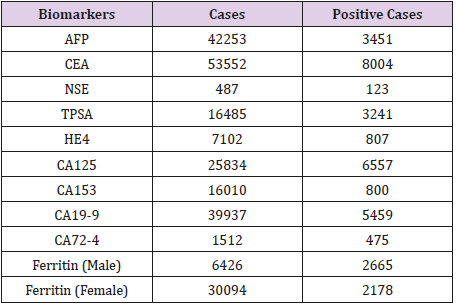
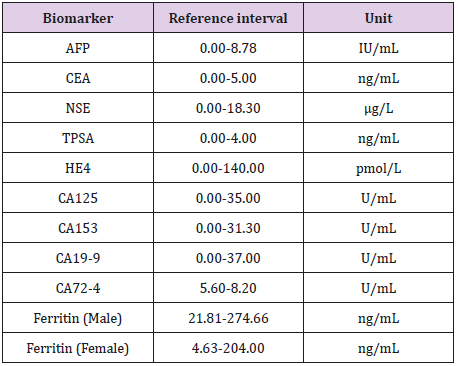
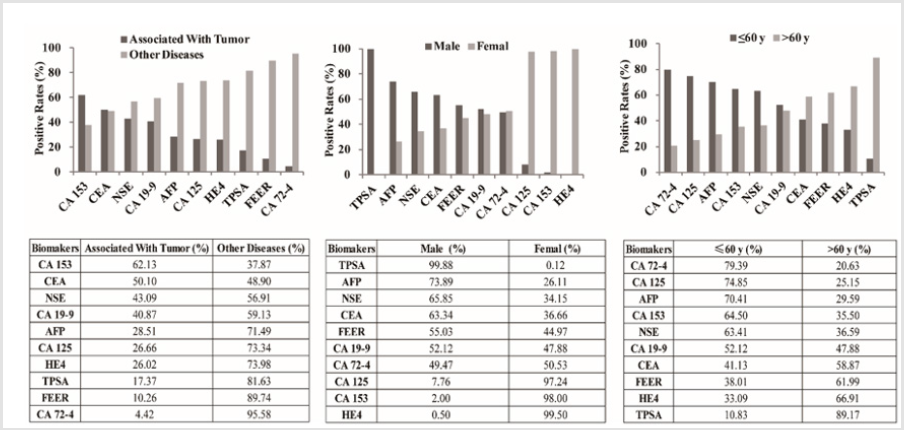
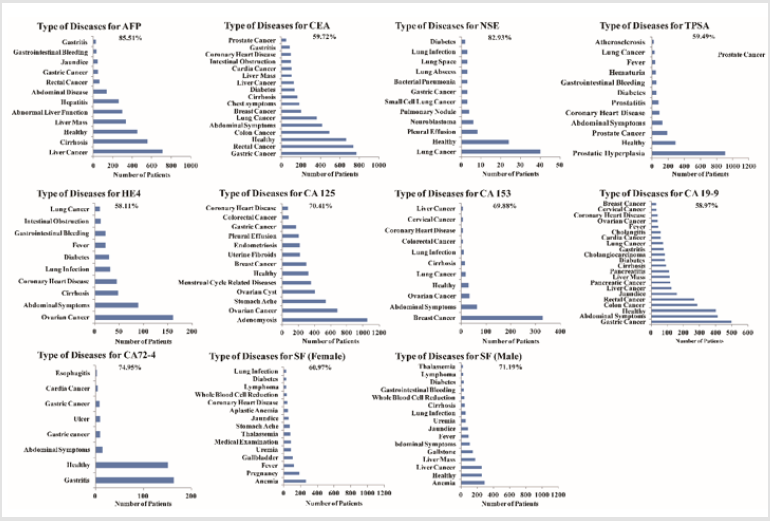
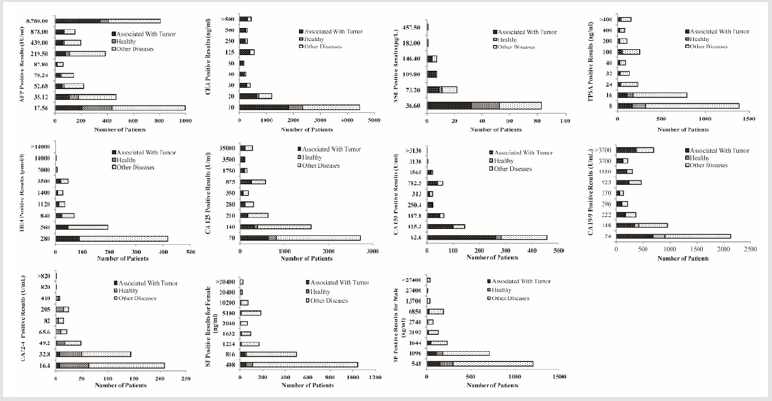


No comments:
Post a Comment
Note: Only a member of this blog may post a comment.